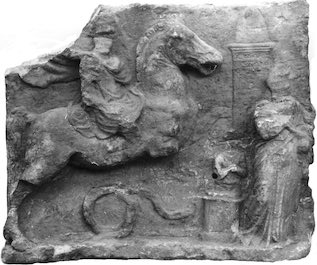Description: Relief panel of medium-grained white marble; composed from three pieces,
the upper left-hand corner lost, all edges chipped, the surface encrusted as well as worn away in places
(w:
0.415 x h:
0.34 x d:
0.063; depth of relief 0.029).
Text: The relief as a whole presents a male figure on horseback
(both man and horse damaged), riding rightwards towards a draped woman and a boy (damaged) who stand beside a cylindrical
altar; above the
boy there is an inscribed stele with conical top, and under the horse a snake which uncoils and reaches towards the altar.
A dowel hole (depth
0.015, diameter 0.007) by the right leg of the boy may have served to attach the horse’s front leg to the background. The
text is
inscribed on the stele shown in the relief.
Letters: Not recorded.
Date: Late first century BCE to early first century CE
Findspot:
Cyrene:
Sanctuary of Demeter and Kore: area F13/G13, 2, 2.
Original location: Unknown.
Last recorded location:
Cyrene Museum, Storeroom of the American excavations
(Inv. no. 77-377)
English translation
Translation source: Reynolds, 2012
Theodoros (scil. son) of Theodoros, hero
Arabic translation
Translation by: Muna Abdelhamed
ثيودوروس (بن) ثيودوروس ، بطل
Commentary
The figure on horseback, who may be pictured as an ephebe or a neos, is clearly deceased, and I take the stele to represent his funerary monument which, with the altar dedicated to a funerary cult, will have stood in the courtyard in front of his tomb, in the manner common in the Cyrene cemeteries, at any rate until early in the second century CE The courtyard normally also contained a half-figure of a mourning woman and the female figure here may represent her.
In the inscription the deceased is named and described as ἥρως, hero, i.e. a superhuman post mortem existence is attributed to him, as also to the subject of C.468. The panel was found in what might be described as a dump into which many stones from the adjacent cemetery might have been swept; but if dedication in the sanctuary is thought more likely, this divinisation deserves to be regarded as a genuine and comforting belief by his surviving family.
A dedication of this kind in the Sanctuary would presumably indicate that in some part thereof Kore’s identity with Persephone (locally Persephatta) as Queen of the Underworld was a feature of the cult.
It should be noted that the names preserve in Cyrenaean dialect forms (Θευ- for Θεο-, and -ω for -ου in the genitive singular masculine).
Bibliography: Mentioned White, 1978-1979, 61, pl. LIV, A, and White, 1987, 1, , whence Dobias-Lalou, Bulletin Épigraphique, 1989.830, SEG 37.1701bis; Kane, 2003, 2, whence Dobias-Lalou, Bulletin Épigraphique, 2004.446, SEG 53.2055; Reynolds, 2012, A.38, whence SEG 62.1795.19; further discussion by Dobias-Lalou, 2016b, 167.
Text constituted from: Transcription (Reynolds).
